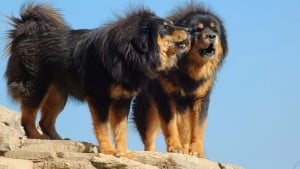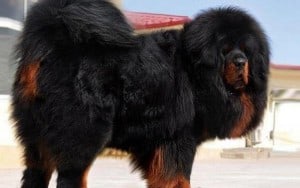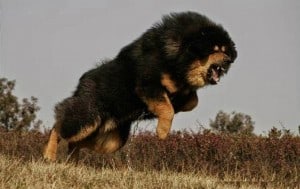
Tibetan Mastiffs are quite loyal to their families and most are good with children and other animals, especially when socialized at an early age. They are protective of their perceived territory and for this reason they make good guard dogs. They stand their ground with other dogs and are cautious of strangers. They are fairly low energy dogs that, while friendly to their families, most do not enjoy games such as chasing a ball. Tibetan Mastiffs only shed once a year and they have very little doggie dander. For this reason can be good dogs for those with allergies.
Because of their large size and independent nature, some obedience training is recommended to control a Tibetan Mastiff in public situations. Tibetan Mastiffs do best in a spacious yard with a canine companion. They should not be kept in small houses or apartments, and they tend to be rather sedentary while indoors, so a larger yard is a must. These are large dogs that can dig large holes. While flock guardians are homebodies, they do require a minimum of a 6-foot fence.

There are two distinct varieties in the breed, the smaller and more common shepherd variety (averaging 70 to120 pounds and 24 to 27 inches at maturity), and the giant mastiff type (averaging120 to170 pounds and 26 to 31 inches at maturity), and they are not to be confused with the English Mastiff that can weigh as much as 220 pounds. They have a long, thick, weather resistant double coat, which appears thicker in colder climates and winter months, shedding in late spring to a significantly thinner coat for the summer.
They have a mane around the neck and shoulder areas and a thick, furry tail that curls over the dog’s back. The Tibetan Mastiff comes in a full range of colors that include solid black, gold (cream to red shades), black and tan, gray and chocolate. White markings may be found on the breast, chest, and feet. They have moderately sized pendant ears that give the head a larger appearance when held at attention.
The Tibetan Mastiff was originally bred as a family and flock guardian, with its main responsibility to guard livestock from predators that included wolves and leopards. Their skills and ferocity were so great that one dog would be used to guard an entire Tibetan village. While Tibetan Mastiffs have become quite rare in their native Tibet, since Tibet first closed its doors to visitors from the West, they were likely the ancestors of many other breeds of mastiffs.

Tibetan Mastiffs should be brushed daily. Their energy levels are not particularly high. One walk a day should be sufficient. Because they are so large, over-exercise (such as overly brisk walks or jogs) can cause damage to their joints. However, lack of exercise can also cause joint problems, as well as obesity.Some health concerns common among Tibetan Mastiffs include hip dysplasia, hypothyroidism, skin conditions, ear infections, bloat, and a genetic disease known as Canine Inherited Demyelinative Neuropathy.
